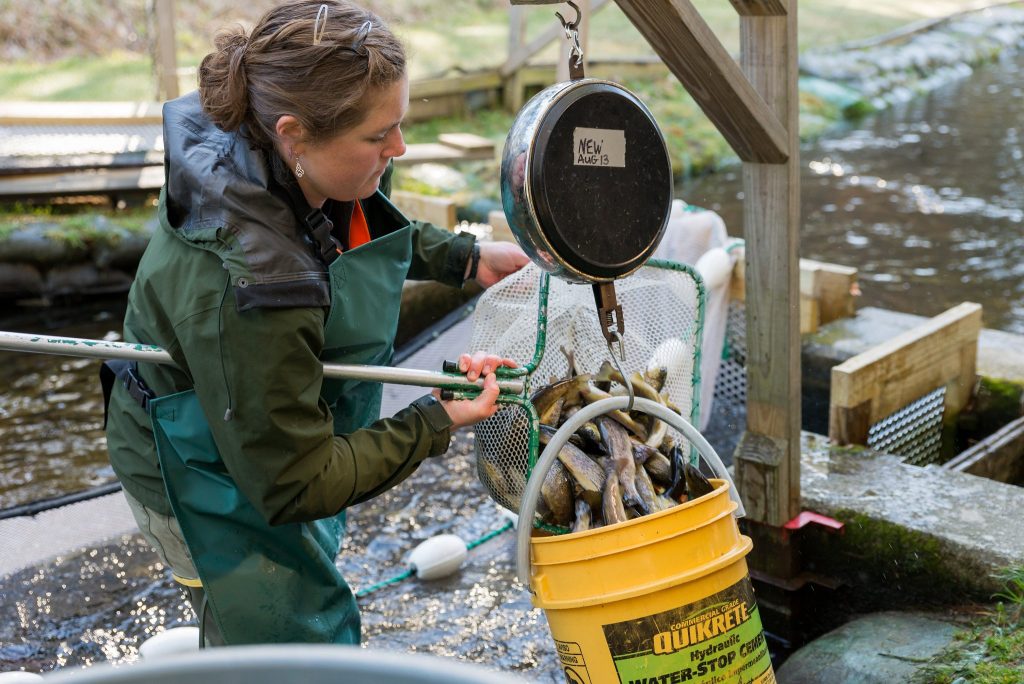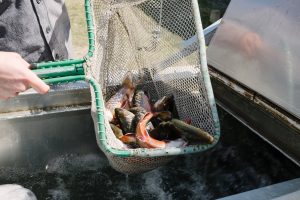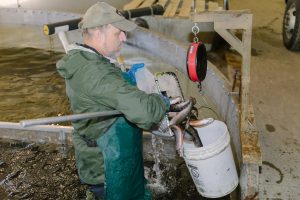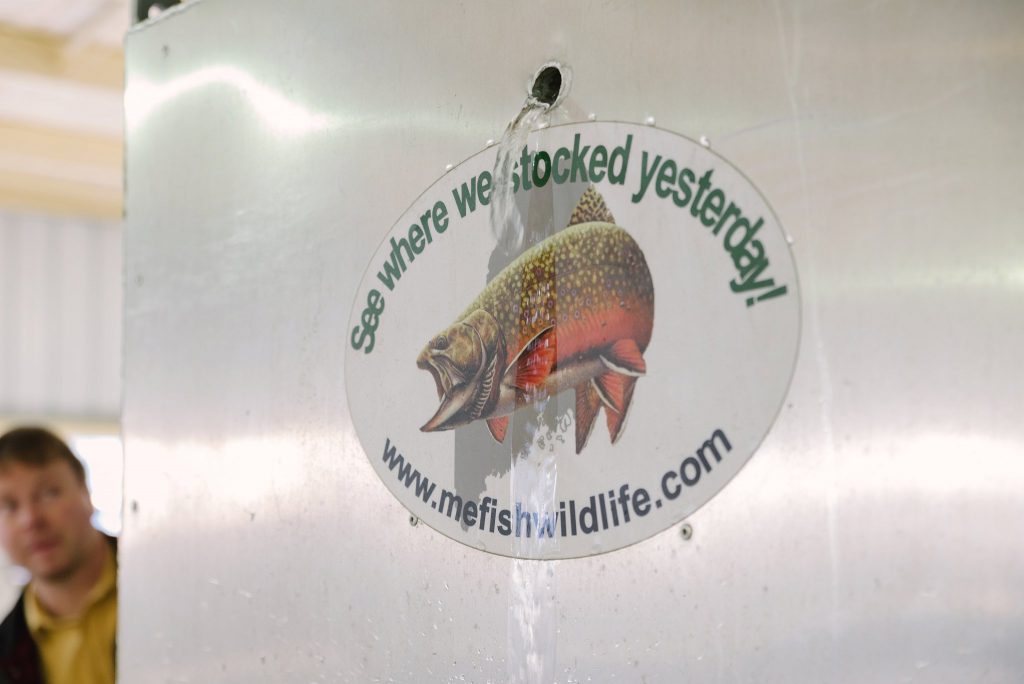May 5, 2017 at 3:38 pm
 We receive lots of questions regarding fish stocking in Maine. Why do we stock? Why don't we stock more? What species do we stock and why? Why do we stock varying sizes and ages of fish? Read on to learn more about Maine's fish stocking program.
Maine stocks well over a million fish each year. Most of these fish are six inches or larger when released into the wild. The Maine Department of Inland Fisheries and Wildlife's (IFW) fish culture program consists of growing various species of trout and landlocked salmon. We are currently raising brook trout, brown trout, lake trout (togue), landlocked salmon, splake (a brook trout/lake trout hybrid), and rainbow trout.
We stock fish to provide fishing opportunities for anglers that would not otherwise be available. Many of the state's nearly 6,000 lakes and ponds and almost 32,000 miles of rivers and streams present some type of angling opportunity, as well as management challenges.
We receive lots of questions regarding fish stocking in Maine. Why do we stock? Why don't we stock more? What species do we stock and why? Why do we stock varying sizes and ages of fish? Read on to learn more about Maine's fish stocking program.
Maine stocks well over a million fish each year. Most of these fish are six inches or larger when released into the wild. The Maine Department of Inland Fisheries and Wildlife's (IFW) fish culture program consists of growing various species of trout and landlocked salmon. We are currently raising brook trout, brown trout, lake trout (togue), landlocked salmon, splake (a brook trout/lake trout hybrid), and rainbow trout.
We stock fish to provide fishing opportunities for anglers that would not otherwise be available. Many of the state's nearly 6,000 lakes and ponds and almost 32,000 miles of rivers and streams present some type of angling opportunity, as well as management challenges.
 Fish stocking 100 years ago was done with little knowledge of the habitat requirements for a given species and with little understanding of the complexities of lake and river ecosystems. In the early 1950's, fishery biologists began to study these ecosystems to gain an understanding of how they operated in order to make informed decisions for future management. As more information was gathered, management recommendations resulted in a variety of stocking changes. In many situations the species to be stocked was changed - for example, at one time Maine stocked four species of Pacific salmon! In other instances changes were made in the size of fish stocked. Millions of tiny fry were once planted in many waters with large populations of predatory fish, resulting in few returns to anglers. In addition, many stockings - especially in brooks and streams - were stopped completely because we learned that natural reproduction could produce more than enough fish to support a fishery for wild fish.
Fish stocking 100 years ago was done with little knowledge of the habitat requirements for a given species and with little understanding of the complexities of lake and river ecosystems. In the early 1950's, fishery biologists began to study these ecosystems to gain an understanding of how they operated in order to make informed decisions for future management. As more information was gathered, management recommendations resulted in a variety of stocking changes. In many situations the species to be stocked was changed - for example, at one time Maine stocked four species of Pacific salmon! In other instances changes were made in the size of fish stocked. Millions of tiny fry were once planted in many waters with large populations of predatory fish, resulting in few returns to anglers. In addition, many stockings - especially in brooks and streams - were stopped completely because we learned that natural reproduction could produce more than enough fish to support a fishery for wild fish.
 IFW’s fish stocking programs fall into four categories: introductory stocking, maintenance stocking, experimental stocking, and put and take stocking. Introductory, maintenance, and experimental stockings fall into a broad category of "biological" stocking programs. Waters selected for these programs have been assessed and have habitat, water quality and forage suitable to allow a stocked fish to survive and grow to legal size; that is, a minimum legal length limit and/or a lower bag limit may be applied to allow the stocked fish to use the lake’s food supply to survive and grow to older ages before harvest. These programs are often referred to as “put-grow-take” stockings.
Of these three types of programs, the introductory one is the smallest. In an introductory program we consider all habitat conditions to be suitable, including sufficient spawning and nursery areas for the species being stocked. After a few years, stocking can usually be discontinued and the fishery will maintain itself through natural reproduction. In fact, several of our wild brook trout and togue populations have established self-sustaining populations with only a single stocking.
The largest part of Maine's fish stocking program is considered a “maintenance” program, where routine, continuous stockings (on various time tables) are made to supplement an insufficient amount of natural reproduction, or many cases, to substitute where there is a complete lack of natural reproduction. The lack of natural reproduction is generally a result of no suitable spawning and nursery habitat, but it can also be related to the presence of large numbers of predator or competitor fish, such as bass, pickerel, or perch.
IFW’s fish stocking programs fall into four categories: introductory stocking, maintenance stocking, experimental stocking, and put and take stocking. Introductory, maintenance, and experimental stockings fall into a broad category of "biological" stocking programs. Waters selected for these programs have been assessed and have habitat, water quality and forage suitable to allow a stocked fish to survive and grow to legal size; that is, a minimum legal length limit and/or a lower bag limit may be applied to allow the stocked fish to use the lake’s food supply to survive and grow to older ages before harvest. These programs are often referred to as “put-grow-take” stockings.
Of these three types of programs, the introductory one is the smallest. In an introductory program we consider all habitat conditions to be suitable, including sufficient spawning and nursery areas for the species being stocked. After a few years, stocking can usually be discontinued and the fishery will maintain itself through natural reproduction. In fact, several of our wild brook trout and togue populations have established self-sustaining populations with only a single stocking.
The largest part of Maine's fish stocking program is considered a “maintenance” program, where routine, continuous stockings (on various time tables) are made to supplement an insufficient amount of natural reproduction, or many cases, to substitute where there is a complete lack of natural reproduction. The lack of natural reproduction is generally a result of no suitable spawning and nursery habitat, but it can also be related to the presence of large numbers of predator or competitor fish, such as bass, pickerel, or perch.  We often get the question: Do stocked fish spawn? Yes, indeed they would spawn very nicely if there were suitable habitat conditions for successful spawning and rearing of young fish. Many of Maine's waters have great habitat for growth and survival of adult or sub-adult fish, but lack spawning and nursery areas, so our maintenance stocking program must continue if good sport fisheries are to be sustained.
The last of our three “biological” stocking programs is experimental. Experimental stocking is used in special situations to help us predict the success of a new program where complex biological interactions occur. Fish may be stocked on a trial basis, and once information is gathered, the program may be changed, continued, or stopped entirely, depending on the results of the stocking. Recent examples of experimental programs include stocking of brown trout in certain tidal rivers, tests of new strains of brown trout, trial stockings of rainbow trout in several waters in central and southern Maine, and plantings of lake whitefish in several northern Maine lakes.
We often get the question: Do stocked fish spawn? Yes, indeed they would spawn very nicely if there were suitable habitat conditions for successful spawning and rearing of young fish. Many of Maine's waters have great habitat for growth and survival of adult or sub-adult fish, but lack spawning and nursery areas, so our maintenance stocking program must continue if good sport fisheries are to be sustained.
The last of our three “biological” stocking programs is experimental. Experimental stocking is used in special situations to help us predict the success of a new program where complex biological interactions occur. Fish may be stocked on a trial basis, and once information is gathered, the program may be changed, continued, or stopped entirely, depending on the results of the stocking. Recent examples of experimental programs include stocking of brown trout in certain tidal rivers, tests of new strains of brown trout, trial stockings of rainbow trout in several waters in central and southern Maine, and plantings of lake whitefish in several northern Maine lakes.
 An important “non-biological” program we employ is called “put and take” stocking, which consists of stocking legal-sized fish into waters where they are expected to be caught and harvested within a short time. These waters generally do not provide the right conditions to hold trout over the entire year. For example, the water may become too warm in the summer, or too low, or there may be very heavy fishing pressure, such as waters near urban areas.
Put and take stocking provides a short-term fishery that must be maintained by continuous stocking during periods when habitat conditions are suitable. Most of this program is conducted in high population areas where angler access is good and other opportunities for trout fishing may not exist. Spring stocking of some brooks in York and Cumberland Counties is one example. Another more recent put and take program that has proven very popular is the stocking of large fall-yearling trout (typically brook trout) late in the year. These fish are highly catchable by open water anglers during the fall months, by ice anglers in the winter, and in some cases by spring anglers at ice-out. These fish are attractive because of their size (usually 12-15 inches long when stocked), their bright fall colorations, and because they are relatively easy for even novice anglers to catch. However, stocking these large fall yearlings into more waters is limited because our hatchery space is also limited during the second summer these fish need to be cultured. Finally, it’s important to realize that programs such as this are not considered for waters that already produce adequate numbers of wild fish.
An important “non-biological” program we employ is called “put and take” stocking, which consists of stocking legal-sized fish into waters where they are expected to be caught and harvested within a short time. These waters generally do not provide the right conditions to hold trout over the entire year. For example, the water may become too warm in the summer, or too low, or there may be very heavy fishing pressure, such as waters near urban areas.
Put and take stocking provides a short-term fishery that must be maintained by continuous stocking during periods when habitat conditions are suitable. Most of this program is conducted in high population areas where angler access is good and other opportunities for trout fishing may not exist. Spring stocking of some brooks in York and Cumberland Counties is one example. Another more recent put and take program that has proven very popular is the stocking of large fall-yearling trout (typically brook trout) late in the year. These fish are highly catchable by open water anglers during the fall months, by ice anglers in the winter, and in some cases by spring anglers at ice-out. These fish are attractive because of their size (usually 12-15 inches long when stocked), their bright fall colorations, and because they are relatively easy for even novice anglers to catch. However, stocking these large fall yearlings into more waters is limited because our hatchery space is also limited during the second summer these fish need to be cultured. Finally, it’s important to realize that programs such as this are not considered for waters that already produce adequate numbers of wild fish. All "biological" stocking programs are done with the benefit of considerable field data, public input, and thought by our Regional Fisheries Biologists. Many years ago Department biologists established a set of guidelines for our stocking programs. These guidelines include recommendations on species to be stocked, size of fish at stocking, and numbers to be stocked. Species, size, and numbers are based on the available habitat for each species, the degree of competition from other fish species, and available forage (feed).
To give our biological stocking programs the best chance of success, fish quality goals (size and condition of fish at a particular age) are established for all species and strains grown in our hatchery system. Department Fish Culturists strive to meet these goals so that good survival occurs after stocking, which assures the greatest returns to anglers. They take great pride in the products they stock and are continually finding ways to improve them.
All "biological" stocking programs are done with the benefit of considerable field data, public input, and thought by our Regional Fisheries Biologists. Many years ago Department biologists established a set of guidelines for our stocking programs. These guidelines include recommendations on species to be stocked, size of fish at stocking, and numbers to be stocked. Species, size, and numbers are based on the available habitat for each species, the degree of competition from other fish species, and available forage (feed).
To give our biological stocking programs the best chance of success, fish quality goals (size and condition of fish at a particular age) are established for all species and strains grown in our hatchery system. Department Fish Culturists strive to meet these goals so that good survival occurs after stocking, which assures the greatest returns to anglers. They take great pride in the products they stock and are continually finding ways to improve them.
 IFW has eight hatcheries and rearing stations. Hatcheries are just that - where fish are hatched and also raised. A rearing station is where some fish are moved to and grown out after hatching. These eight facilities are located on sites that have proven to be conducive to the production of certain species of coldwater fish. Most of them are fed by surface water, while others receive their water supply from springs and underground wells.
Fish production schedules are planned at least two years in advance to assure the number and size of a particular species or strain are available to meet the needs of anglers. Exactly what species are produced by a particular facility is governed by the need for specific species, strain and size of the fish, the suitability of a facility for certain species, and the geographic need for a specific species.
Another "special" program is the stocking of many of our larger, "retired" hatchery brood stock. Brood stock are the parents that produce the fry, fingerlings, and yearlings that IFW stocks throughout the year. They are no longer needed for the brood stock program so they are released into the wild for anglers to catch. Retired brood fish generally range in age from three to five years old, although togue can be held as viable brood fish for as much as a decade. These old-timers give anglers the opportunity to catch a trophy size fish. Brown trout and brook trout typically measure from 16 to 20 inches long and togue can be up to 30 inches long when released as retired brood stock.
IFW has eight hatcheries and rearing stations. Hatcheries are just that - where fish are hatched and also raised. A rearing station is where some fish are moved to and grown out after hatching. These eight facilities are located on sites that have proven to be conducive to the production of certain species of coldwater fish. Most of them are fed by surface water, while others receive their water supply from springs and underground wells.
Fish production schedules are planned at least two years in advance to assure the number and size of a particular species or strain are available to meet the needs of anglers. Exactly what species are produced by a particular facility is governed by the need for specific species, strain and size of the fish, the suitability of a facility for certain species, and the geographic need for a specific species.
Another "special" program is the stocking of many of our larger, "retired" hatchery brood stock. Brood stock are the parents that produce the fry, fingerlings, and yearlings that IFW stocks throughout the year. They are no longer needed for the brood stock program so they are released into the wild for anglers to catch. Retired brood fish generally range in age from three to five years old, although togue can be held as viable brood fish for as much as a decade. These old-timers give anglers the opportunity to catch a trophy size fish. Brown trout and brook trout typically measure from 16 to 20 inches long and togue can be up to 30 inches long when released as retired brood stock.
 And of course, you may wonder just how all these fish get into over 800 lakes, rivers, streams and ponds? There isn’t one process used for all them. It depends on the geographic location of the water body, and its accessibility. Some are stocked by running a hose from a hatchery truck to the water, while some are moved to ponds by a bucket that is filled at the truck. We use airplanes to bring fish to remote ponds where travel by truck is not feasible, and in some areas, we backpack them in as fry in a specially made pack frame designed to carry very small fish. The stocking of many waters also includes the boating of fish to various sections of a water body to spread the fish out and reduce attacks on them by predators such as larger fish or birds.
And of course, you may wonder just how all these fish get into over 800 lakes, rivers, streams and ponds? There isn’t one process used for all them. It depends on the geographic location of the water body, and its accessibility. Some are stocked by running a hose from a hatchery truck to the water, while some are moved to ponds by a bucket that is filled at the truck. We use airplanes to bring fish to remote ponds where travel by truck is not feasible, and in some areas, we backpack them in as fry in a specially made pack frame designed to carry very small fish. The stocking of many waters also includes the boating of fish to various sections of a water body to spread the fish out and reduce attacks on them by predators such as larger fish or birds.

Click here for a current fish stocking report and keep up with our daily stocking activities!
Check out a couple short videos from last spring's stocking season!
[embed]https://youtu.be/teBZM7l9TkI[/embed] [embed]https://youtu.be/KI2l07W4ooE[/embed]Categories